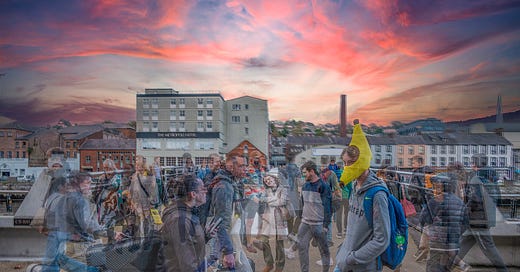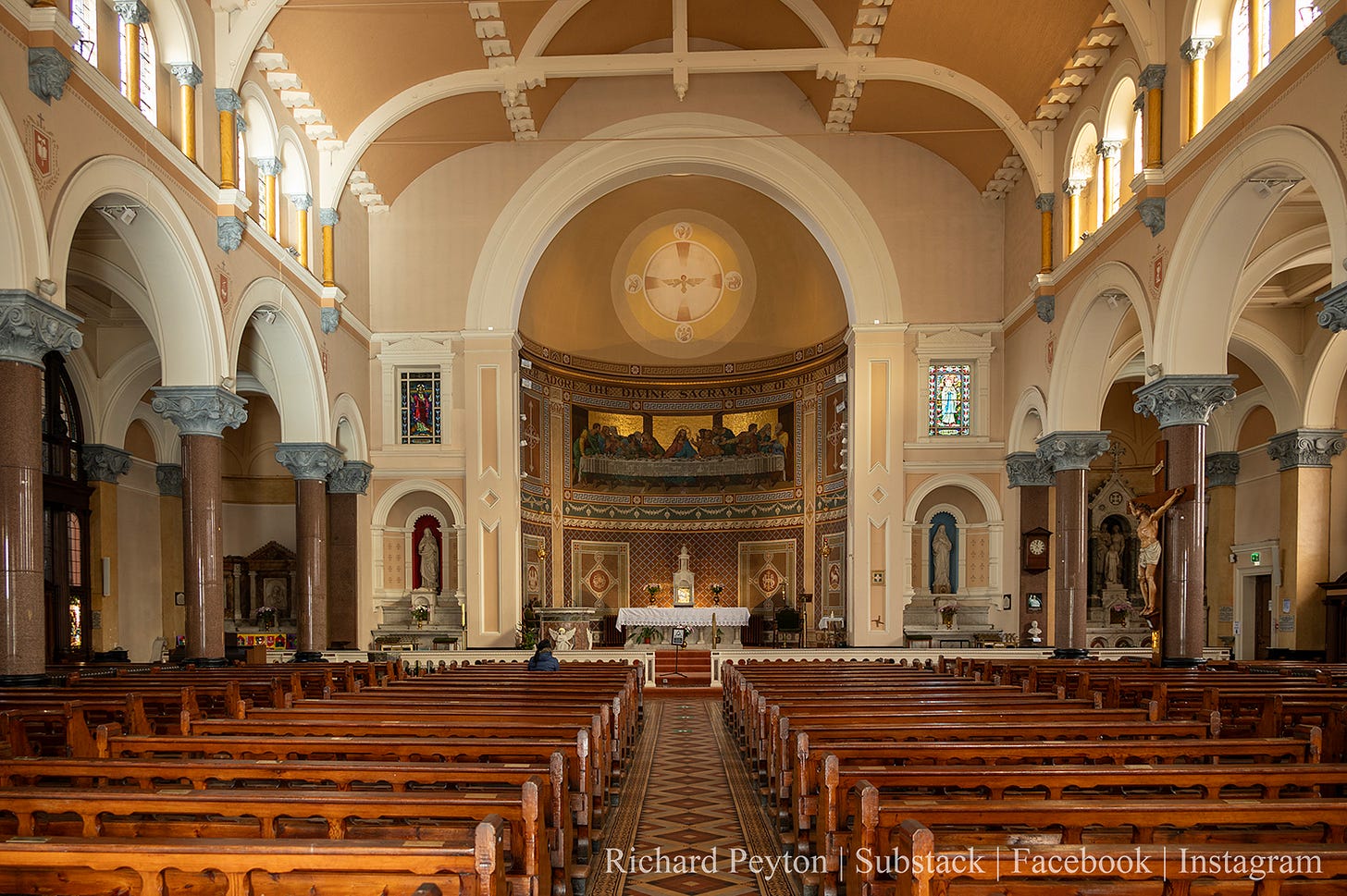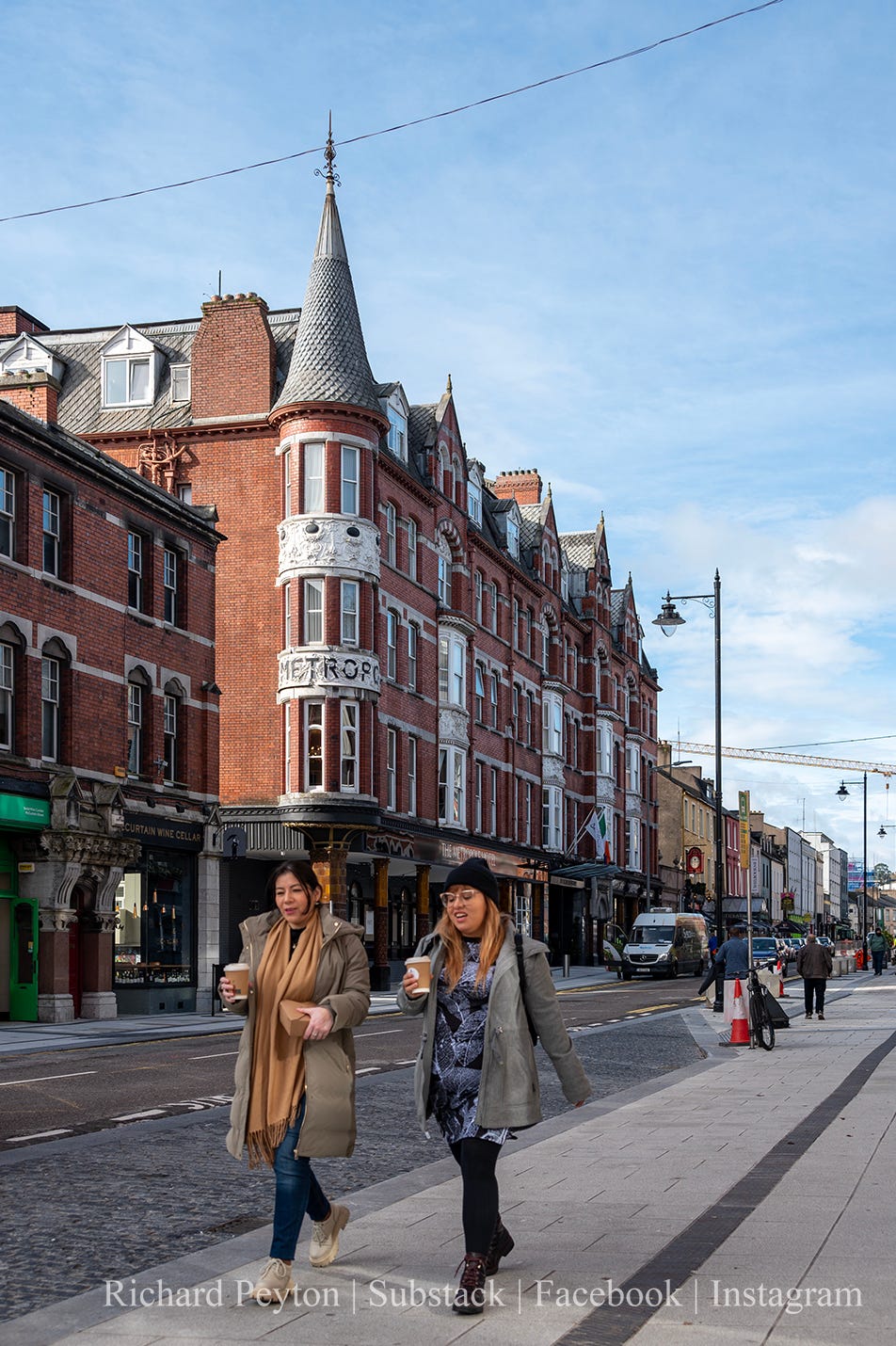A Trip to Cork Gaol, and Other Encounters
“Sure if you get flooding up here the whole city is gone,” says a slightly amused Cork local when I ask him if he was affected by the recent flooding. I’m up at quite a high point in the city waiting to catch what I hope will be a brilliantly coloured sunset, but it doesn’t happen, it is too cloudy. “My brother is in Middleton though,” he adds, “and the place is in a bad way, there has never been such bad flooding.” Throughout the day I casually spoke to several people about the recent flooding in Cork. Some believed that the flooding was to do with climate change while others believed that it was due to a lack of a proper drainage system in the area. Whatever the cause, it’s no doubt incredibly devastating to the people that live in the area, and as I understand it a lot of the people in these areas do not have insurance as they are deemed too high risk by the insurance industry.
I came to Cork to try and understand the city a bit more and for that purpose I downloaded a book called Cork City History Tour by a Kieran McCarthy, who happens to be the mayor of the city as well as a history enthusiast. In his book he briefly details 51 historical sites in and around the city, which seems a perfect jumping off point upon which to navigate through my day. I read through the whole book on the three-hour bus journey from Cork to Galway and fancy I might use it as a rough guide to explore some of the 51 sites and take a few pictures in the 7-hour window I happen to be there. I happen to alight from the bus at stop 51 in the book and so decide to work my way backwards through it, starting at St Patrick’s Church, which opened on the 1st of July 1848. Here is a picture on the inside.
The next stop on from my newly acquired guide book is the Metropole hotel which has some rather fascinating history behind it. It was built and run in the latter quarter of the nineteenth century by brothers Stuart and Thomas Musgrave. I learn from McCarthy’s book that they first went into business in 1876 when they were eighteen and twenty-five years old respectively. They started with a grocery store and went on to grow and expand Musgraves Cash & Carry which today serves over 3,000 stores in Ireland, the UK, and Spain, and has an annual turnover of €4.4 billion.
Unfortunately, some of the next stops on the route I acquire from McCarthy’s book, such as Collins Barracks and the Lifetime Lab are closed at the weekends and so I resolve to make them part of my next visit. After walking around a bit, I arrive at Audley Place and am greeted by a positively breathtaking view of the city from above. The feeling from up here is akin to when I first saw the Cliffs of Moher, the landscape of the Burren, or Dunquin Pier. If you’ve never been to such places then simply imagine a piece of landscape that you saw that awed you. The view of the city is panoramic, literally.
My next stop is a quaint little suspension bridge which is called Daly’s Bridge. It’s a spot I never would have come across only for McCarthy’s guide book and I feel there’s a good opportunity for a timescape sort of photo here (kind of like the one in the header) but the field of view is a little too narrow to take such a series of pictures in any meaningful sort of way. While doing so, I talk to a few random strangers who are a little curious as to what I am doing. I had a brief chat with the lady in the picture below about her dog, and I was going to tell her I probably captured her in my series of pictures so as I could send her a copy, but alas my phone rang when we were talking and so I didn’t get a chance.
My next port of call on my little micro photo/history walk is the old Cork City Gaol, which is quite possibly the highlight of my visit. Built in 1824, it was apparently quite an upgrade on previous standards of jails prior, and a testament to this is the witness of Countess Markievicz* who was sentenced to four months there in 1919. She described the conditions as “quite good” by comparison to previous jails she had stayed in. Throughout the jail are told the stories of various prisoners which were comprised of men, women, and children. Through their stories I learn that the fate of various prisoners included a life of poverty begging in the streets, being transferred to lunatic asylums or workhouses, and, if the prisoner happened to have a lengthy sentence, being transported to Australia as the cost of transportation was cheaper than keeping them in the prison.
Disease was often rampant in the prison with hospital reports from 1872 and 1866 listing quite a large number of cases of things like typhus, gastric infections, dropsy, epilepsy, and even smallpox. In 1922, the prison was seething with vermin. In spite of this, during the years of the 1840s famine, the poor would often commit crimes in the hopes of being sent here as at least they would be fed and clothed. The food mainly consisted of corn, gruel, and milk, and ordinary prisoners were given just enough to keep them alive and able to do their work. On the other hand wealthier prisoners could have food brought in from the outside. Prisoners in solitary subsisted on only bread and water.
After my time in the city’s former jail, which closed in 1923, I realised I only have about two hours before I have to take the bus back to Galway and so I don’t really have much time left to explore other sites as mentioned in Mayor McCarthy’s book, and so I content myself with attempting to take a timelapse photo at the back of the Metropole hotel (the photo in the header).
All the people in this picture were there during a 20-minute period. A couple of homeless men approached and asked to make sure they weren't going to be in it, and I had a nice chat with them. One guy ended up that way as he split up with his wife, and he didn't want his children seeing pictures of him online in his current status. The other guy was homeless because he injured his back. I asked them what they do for meals and such and they told me they are well fed by the Cork Simon Community.
I always feel bad whenever I see homeless people (and there's a lot of them these days) and wish I could do something to help them. I'm not exactly Richy Rich, but I have a nice warm bed to sleep in and a lot of people don't, and meeting people that don’t makes me feel appreciation for what I have. One of the men I met is sleeping in a tent and the other is sleeping in whatever doorway he can find. After a time chatting with them, I shake their hands and we part company as I have to catch a bus, but I feel quite pensive about the prospect of people having to sleep outside in the cold seasonal temperatures that are starting to kick in. I was supposed to be doing the Dublin marathon this year but I sprained and cracked my ankle in two places. Instead, I decide I'm going to go up and take a bunch of photos and I shall send an original copy to anyone who wants one in return to a donation to a fundraiser I have setup for the Simon Community.
My bus is at 7pm and sunset is at 6.30 and so I head back up to Audley Place where I had been earlier, in the hopes of capturing a nice colourful picture of the city, but it’s too cloudy and gloomy. On the green area just below Audley Place a gray haired drunken looking man in his 50s is singing to a couple of Chinese girls who are taking selfies whilst trying to completely ignore him. To my right are a group of French lads who appear to be a part of a music group and they are being filmed with a fifth guy who is using a drone while they stand there overlooking the city and trying to look as cool as school. The sunset I had hoped for doesn’t arrive, and so I chat for a couple of minutes to the guy mentioned in the opening paragraph and then head to the bus stop.
Dusk is starting to descend now. The neon lights of the clubs and takeaways have started to glow and restaurants and pubs are starting to fill with people taking in the Saturday night life. At the bus stop the there are two cars parked in the bus lane and so the bus driver can’t get around the corner to park to pick up passengers. The drivers of one of the cars tries to make room for the bus and ends up backing his car into a poll. The other car is a taxi with nobody in it and the bus driver, in an incredible testament to his ability to drive, manages to squeeze past it with no more than six inches to spare and it’s a minor miracle to me that he manages it without ripping the side off of it. Because he was delayed trying to park at the bus stop traffic builds up behind him and they keep beeping aggressively at him even though it isn’t his fault. I read somewhere that the rate of heart attacks is disproportionately high in bus drivers and with the display I have just witnessed it’s really not hard to see why.
When the bus gets going, I sleepily ponder the day I had and feel that I will return soon to explore some of the other 40 pit stops in Mayor McCarthy’s book. There are two girls opposite me blabbering away and using the word “like” at least once in every five words.
“He was, like, sitting beside me, like, on the couch, like, and then he, like, puts his arm around me and, like, moves in to kiss me, and I was like, oh my god, like, what are you doing, like? And then he like, tries it again and I said ‘stop, like.’”
Her friend is delighted with this tantalizing story of passion and exclaims, “Oh my god, like!” She is almost squealing with the excitement of it all, and the two of them are giggling like mad. I find it mildly amusing at first, but after a while I start to, like, find it kind of annoying, and so I plug in my headphones and watch something crap on Netflix on my, like, phone, like.
If you’d like to support my work, but don’t wish to become a paid subscriber, then feel free to buy me a coffee :-).
Footnote
*Countess Markievicz was an important female figure in Irish history. She opposed British rule of Ireland, was the first woman elected to Westminster, and fought in the 1916 rising.










